 Michael Beer
Michael Beer
Cahners-Rabb Professor of Business Administration,
Emeritus at the Harvard Business School,
Chairman and co-founder of TruePoint a research based consultancy.

sustained change.
Dissatisfaction (D)with the status quo
(we are not as effective as we need to
be, our organization is not functioning
well and/or our employees are not
committed) is essential if the energy
and motivation to change is to be
released among employees. The first
task of leaders is to "create
dissatisfaction with the status quo."
That can be done by highlighting
current or potential performance
problems, making manifest and
discussible concerns by customers
and shareholders and enabling lower
level to speak truth to power (Our
research shows that lower levels
know what the problems are but
cannot discuss them with senior
people due to the fear created by
hierarchy).
Leaders must also develop a strategic
and orgnaizational model (M) of the
future state. How will be organized?
What values will drive behavior?
What psychological contract will we
create that will govern the
relationship between employees and
the firm? To create D and M, leaders
must create a process (P) of employee
engagement that will reveal barriers to
effectiveness and raise dissatisfaction
(D). Such a process must enable the
senior team in partnership with its
employees to craft a new systemic
orgnaizational solution (M).
These three ingredients (D, M and P)
must be strong enough to overcome
the resistances that will come as
managers and employees realize that
implementation of a new model will
result in losses—losses in power,
esteem, competence, relationship,
rewards, security and identity (who
am I and who are we as a firm). The
prospect of losses is the cost (C ) of
change.
As a practical manner, the formula
suggests that leaders have to spend a
lot of time in the front end of the
change process developing "D" and
readiness to change. By doing this, top
change initiative will not become
failed programs (see earlier discussion
for why initiatives fail). They must
also develop a process (P) of
engagement with employees (task
forces and project teams) that will
yield jointly crafted solutions (M).
Leaders who heed the lessons of the
change formula will not spend
millions of dollars on consulting
firms. These firms develop a new
strategic and organizational model
(M) for the organization and through
"change management" (see my own
earlier criticism of this term) find
ways to educate and persuade
employees that these externally
generated solutions are the right ones.
This is not engagement. Moreover,
consultants do not know the business
and organization and are therefore,
likely to suggest changes that cannot
be implemented.
Let's now for a moment look at
resistance to change. Why is it that
organizations (as artificial persons)
and individuals resist change? What
are the stumbling blocks for change
initiatives? What do you think the
companies should do to get them out
of their "comfort zones" or shells and
start looking at better tomorrows?
As discussed in my answer to
question 14, resistance occurs
because people fear they will lose
something the cost of change. It is
the fear of losses that creates
emotional resistance to change. If
change did not lead to anxiety over
losses, there would not be resistance.
The essence of all effective change is
to help people accept losses for the
INTERVIEW 8
greater good (the success of the
enterprise, the enactment of a
meaningful mission and long term
security). This is the process of
developing a strong D and a powerful
M that people come to believe will
ensure success in coping with the
competitive environment. In my
experience and research, it is senior
management that has most to lose
power, status, rewards and challenge
to their strategic and managerial
assumptions. In most instances,
people at lower levels are eager to see
change in the system, though they
may later confront the implications
for them. They typically have less to
lose. That is why the Strategic Fitness
Process (See Beer and Eisenstat, How
to Have An Honest
Conversation About Your Business
Strategy, HBR, February 2004) we
have developed is structured to
enable truth to speak to power. Our
research shows that urgency to
change is ignited when the truth is put
on the table and made discussible and
when that truth is delivered by lower
level on whom management knows
they must rely to succeed.
